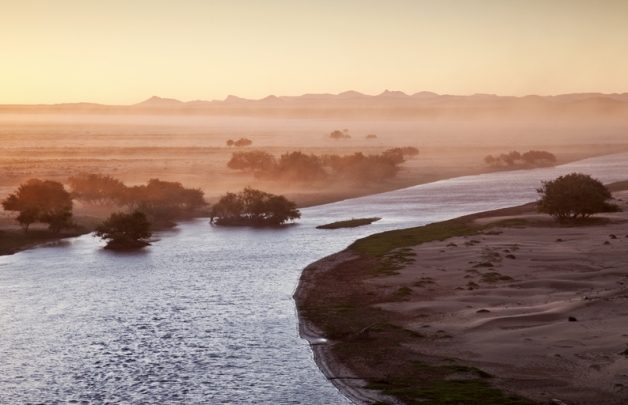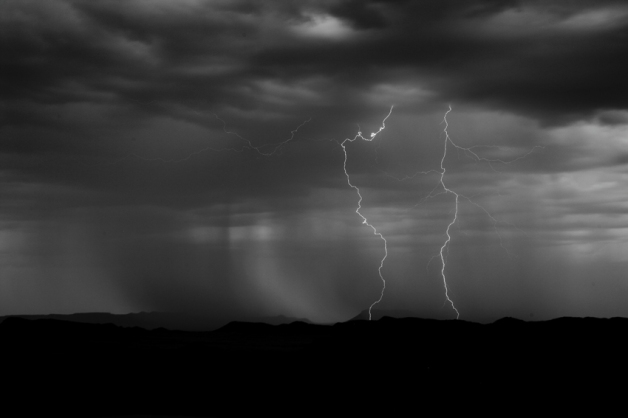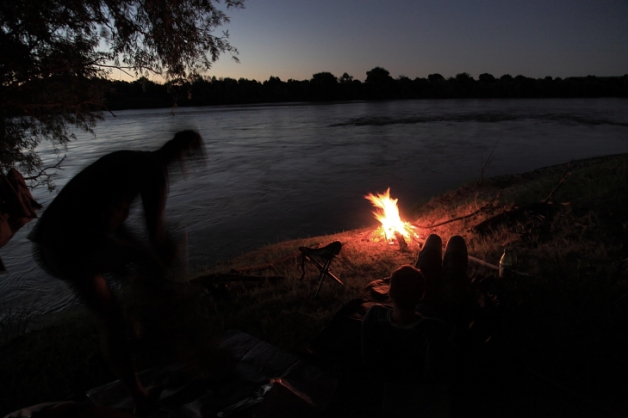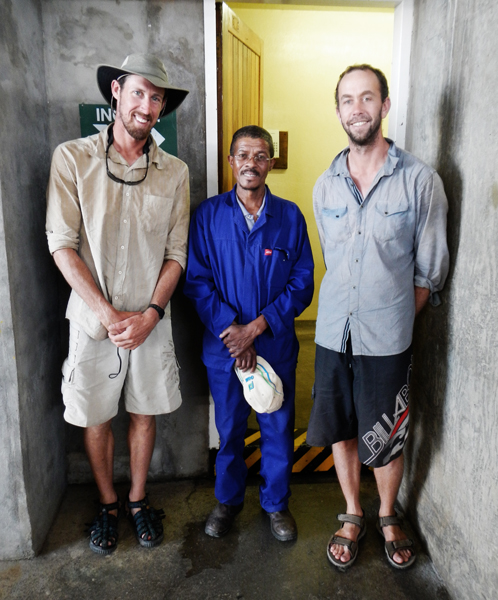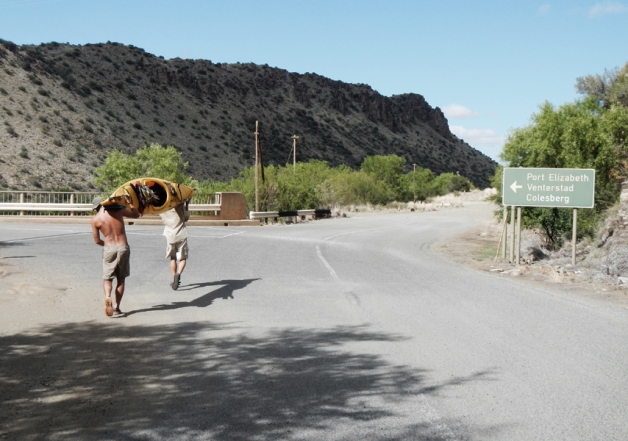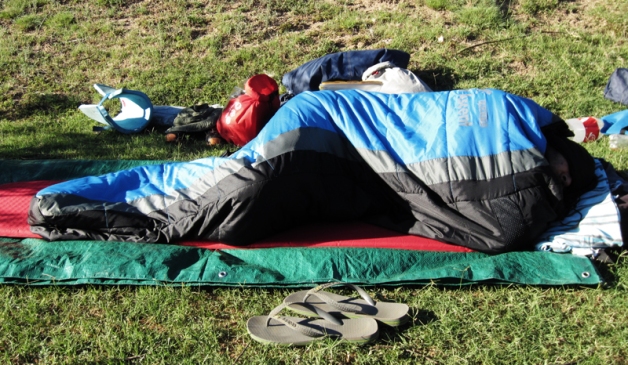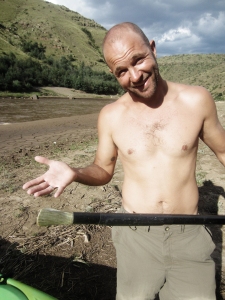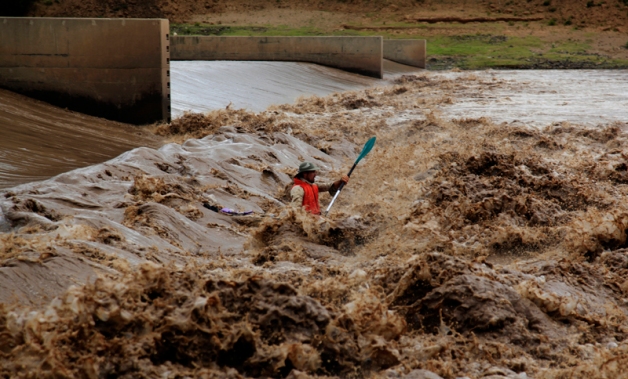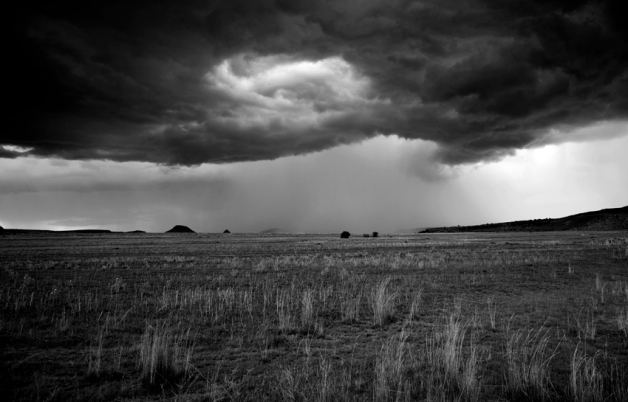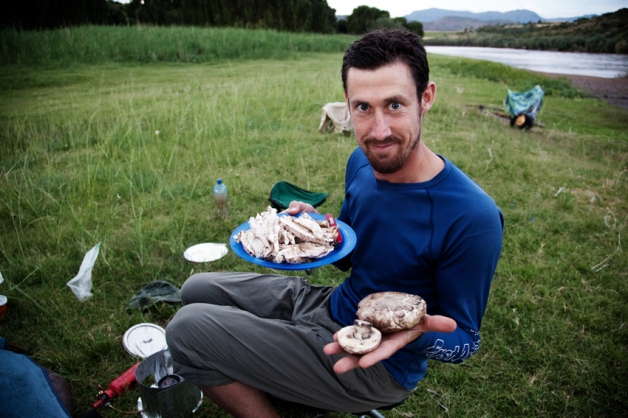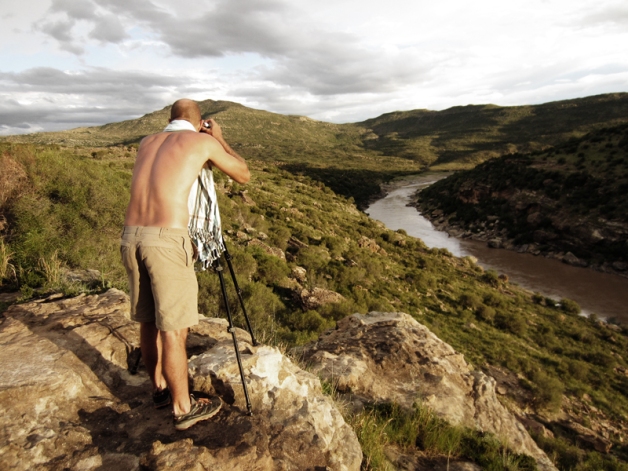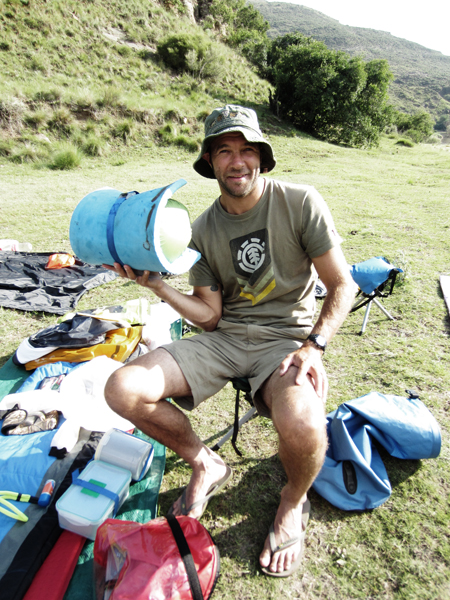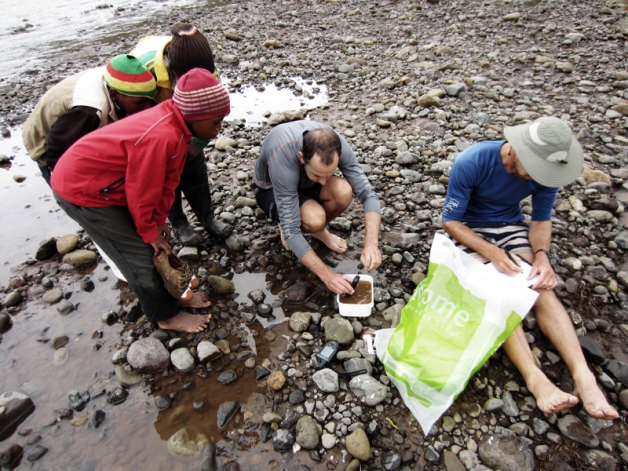We’re a little downstream of the town of Vanderkloof, and finally clear of the two dams – the !Gariep and the Vanderkloof – that have to a large extent been the reason for our lack of correspondence. Paddling days have been long and strenuous, leaving little time for writing.
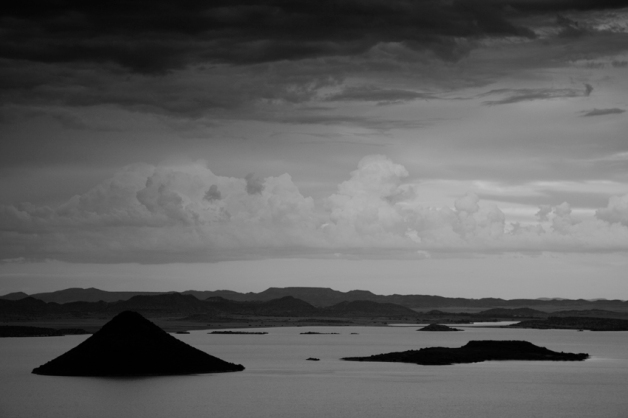
The !Gariep Dam is truly enormous and we were glad to have a GPS to help us navigate our way through the maze of bays and island koppies.
It’s hard to say where the !Gariep dam begins. We noticed the river slowing appreciably about 30kms outside of Aliwal North. From there it’s a long hard slog of 140km to the wall of South Africa’s biggest dam. Ignoring all advice we had received, we set out on our first day on the dam late into the morning. Within a couple of hours we were paddling straight into the teeth of a nasty headwind. We soon gave that up and set up camp in the midst of a developing sandstorm in the desert wastelands near Bethulie. The ghost of Hendrik Verwoerd – the previous name of the !Gariep dam – had scotched our paddling plans, but Sam and James managed to wade across a rising sidestream with R30 000 of photographic equipment raised above their heads to capture some great images from a nearby bridge.
Weather was a constant challenge on the !Gariep dam. Winds were strong and often erratic, not confining themselves to the afternoon hours as we had expected. The dam is truly enormous, often several kilometres wide, and acts more like an inland sea, with winds whipping up large, tightly-packed waves that make paddling an arduous task. One can avoid the worst by hugging the shoreline, but our desire for shortcuts led us to opt for a number of open-water crossings, some more successful than others.
Then there have been the thunderstorms, two in particular having us cowering and invoking various protectors.
A sight etched in memory is James hurtling down the only koppie in the vicinity, (metallic) tripod in hand, having outstayed his welcome in an effort to capture the oncoming storm. A sudden lightning strike had him instinctively leaping 180 degrees and start running back up the koppie, before regaining his wits. On reaching camp he found Sam and Ian waving tent poles – essentially 3m lightning rods – around, furiously getting a tent up. Three bundles of metal, adrift in a sea of inert material. It is difficult to convey the force of the big storms brewed up by the !Gariep – they cover a huge area and yet seem to focus their energy directly on you, rain falling in huge quantities, sheet and fork lightning everywhere, at times close enough to emit a strong smell of burning metal.
That night we had to make do with Salticrax for supper, morale was low – then two harmonicas were brought out and sang as one.
Our route on the !Gariep dam took us, over the course of 4 days, from the riverside dunes near Bethulie to Oviston at the Orange-Fish tunnel and on to the dam wall near the town of !Gariep. The Orange-Fish tunnel is an engineering feat – a hole the size of a double decker bus tunnels through the mountains transporting water from the Orange to the Fish/Sundays rivers, where it services the farmers of the Eastern Cape.

Water inspector Ian Durbach wanted a word with the owner of this water extraction facility…it turns out the Orange-Fish tunnel guys had the correct permits.
For long sections we paddled through nature reserves – first the Tussen die Riviere and then the Oviston reserve – seeing eland, kudu, springbok, and wildebeest. People were almost non-existent.
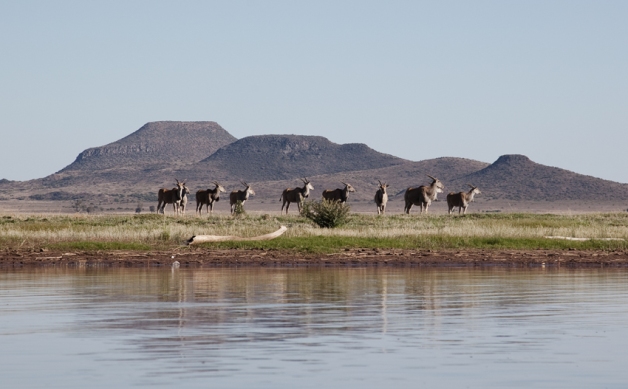
Much of the !Gariep and Vanderkloof dams are bordered by game reserves. Eland were a regular sight and invoked a wilderness feel to this stretch.
At Oviston we overnighted at an abandoned campsite on the dam’s edge, complete with still-working taps and ablutions.
At the dam wall, Sam and James took a trip into !Gariep town for resupply and recreational time travel.
Prefab and facebrick houses line the streets of this small town, and a visit to the chemist to get medicine for Ian, who was down with a throat infection (since recovered), saw them inside someone’s house, where customers wait next to a tannie watching TV and puffing away at Stuyvie reds before going into the room marked “Apteek”.
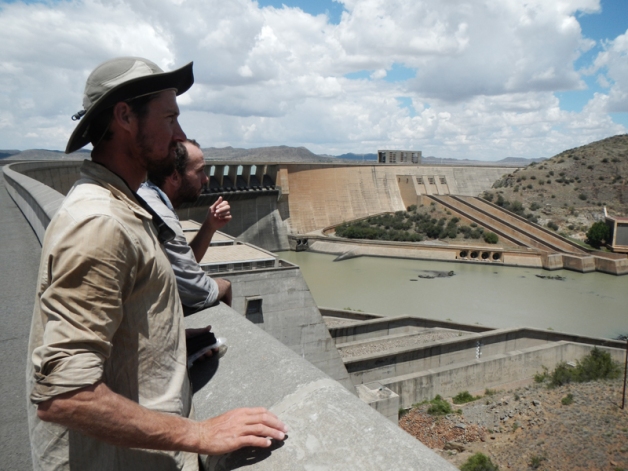
The boys were happy to finally arrive at the !Gariep Dam wall. The view downriver to some flowing water was pretty spectacular.
A highlight at the dam wall was an impromptu tour inside the wall by the dam’s safety manager, Joseph Alexander, who showed us around the inner workings of this amazing structure.
It’s great that this still happens here in South Africa – it’s hard to imagine three bearded and bedraggled men being invited straight off the street to see the structural nuts of bolts of the Hoover dam, for example. We were lucky enough to see the opening of one of the dam’s four main sluices, releasing a huge plume of water downstream to farmers. This happens twice a day for 5-6 hours.
When we told Joseph our plan to paddle the length of the !Gariep, he didn’t miss a beat, dispensing some advice that has become something of a mantra for us: “Guys, please, you must enjoy”.
Whenever we’re paddling into yet another stiff headwind that seems to whip itself up just when we’re at our most tired, James takes it upon himself to remind us why we’re here – guys, please, you must enjoy.
One great thing about the !Gariep dam, unless you’re the dam manager, is that all the sediment carried by the river settles out as the water slows down. The water in the river becomes clearer and clearer as one approaches and pushes beyond the dam wall. As a result we’re now able to drink the water unfiltered, and diatom sampling has improved dramatically – we can actually see the green or “lively brown” (not “dead river brown”, as the manual tells us) film of diatoms on the rocks we’re sampling, much to our relief. Fish life is much more abundant although catches remain elusive. Sam has bagged the only catch of the trip so far – a yellowfish eaten in the aftermath of one of the thunderstorms. Sadly, !Gariep’s grasshopper population is likely to take some years to rehabilitate after a frenzied collection of “bait” for fishing.
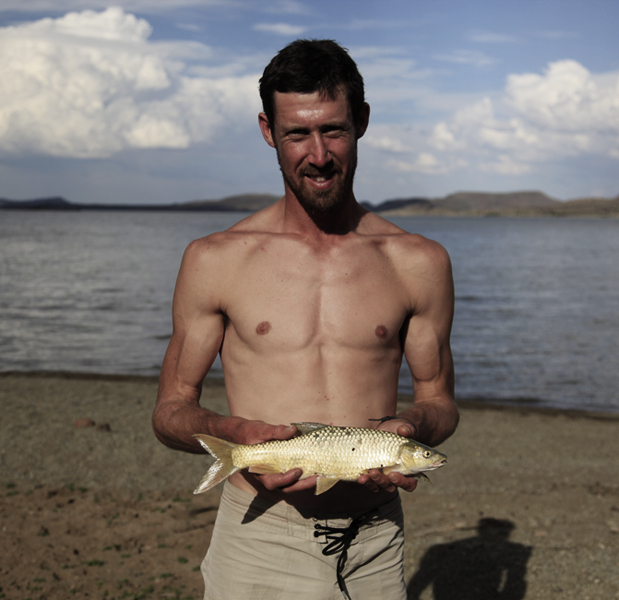
Sam with the one and only yellowfish so far. Nice white meat but very bony…the fish wasn’t too bad either.
The Vanderkloof dam follows closely on the heels of the !Gariep, separated by a fast-flowing 40km stretch of river.
It is South Africa’s second-biggest dam, shorter but much deeper. The banks of the dam are steep and rocky, and we passed through a spectacular gorge section with dolerite cliffs looming above, not a soul in sight except for some baboons.
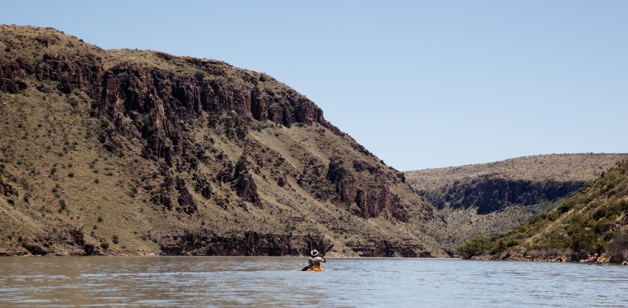
Ian paddling into the gorge at the top of Vanderkloof Dam. For any climbers who might be reading this, there seems to be huge potential for new lines all along the dam, but particularly in the gorge section.
We spent two days paddling the dam, overnighting about half-way at a spot that must boast one of the greatest concentrations of biting ants in the world.
Because of the steepness of the slopes camping options are not abundant, and we were obliged to stick it out. In the face of mounting attack, we conducted a number of ad hoc field tests of the ant-repelling qualities of everyday materials – Tabard and onion don’t work, Camphor cream seems to help a little. Any advice is welcome. The ants seemed to target James for special treatment, and he will probably need a little counselling on his return to get over his compulsive leg-brushing. It did mean though that we got an early start the next morning, that was instrumental in us making the long push to the dam wall that day.
Each dam requires a significant portage to get the boats and their contents down the dam wall and back to the now substantially lower level of the river. Sam and James carried the loads at !Gariep, with Ian conveniently “down ill”; at Vanderkloof, the highest dam wall in South Africa at 110m, all hands were on deck and we were very kindly helped by Gavin, a local kayaker we met on the dam that morning. Gavin went way beyond the call of duty, showing us the best portage route, carrying two loads down with us and giving us some much-needed advice for the rapids to come, having run them many times himself as a guide. Many thanks Gavin!
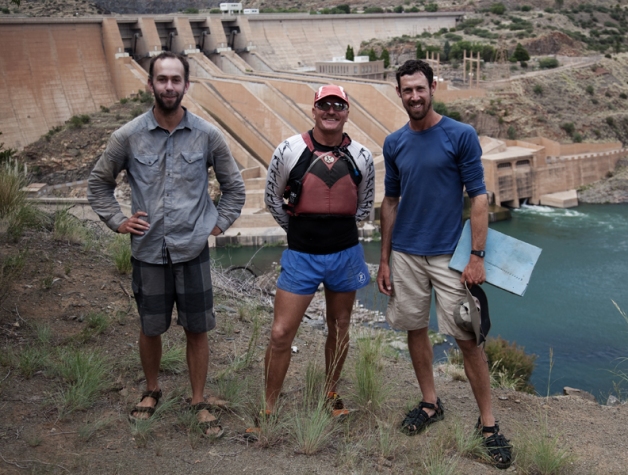
Local river guide, Gavin, was a great help at Vanderkloof Dam wall, showing us the best portage route and carrying a few loads.
From here, we head on to Orania and some fast-flowing water. Things are about to get exciting!

